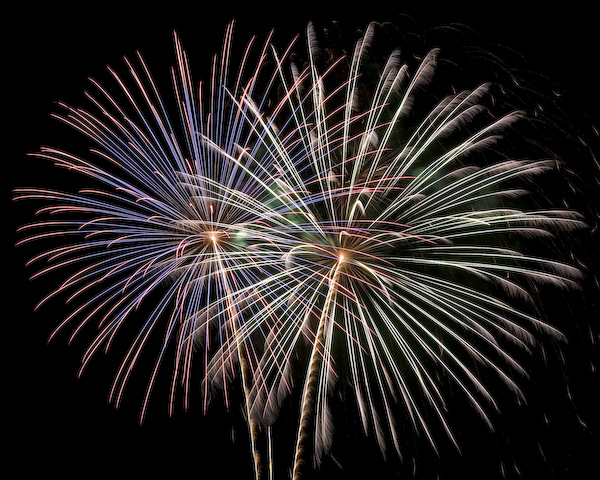Fireworks: Part 1 — Stationary Camera
This is the first of a three-part series on photographing fireworks.
I have vivid memories of being 4 years old and walking with my Mom down to the park one summer evening to watch aerial fireworks. The brilliant flashes and streaks of color, the thunderous sounds quickly following the flashes, the feeling of the cool grass we sat on, the crackle of a string a firecrackers going off a short distance away, the smell of the smoke of those firecrackers, and the oohs and ahhs of the crowd — all of these experiences are linked into one lasting impression for me.
My interest with photographing fireworks began a few years later when, as a teenager, I read an article in a photography magazine discussing techniques. There is an interesting quality to this type of photography: you really don’t know what you’re going to get, and you have to anticipate — if you wait until you see the firework, it is too late to try to photograph it. When using film, it is akin to rolling the dice with every image taken; when going digital, the “film” is free and you’re well served by taking lots of images. Beyond the sheer number of images taken, you’re likely to get better results with a little preparation. The magazine article suggested using Kodachrome 64 and exposing for 1/2s at f/11. The article went on to suggest attempting to move the camera and/or zoom the lens during the exposure. These are techniques I’ll demonstrate in upcoming entries in this blog — for now, we’ll concentrate on keeping the camera and lens fixed.
As for exposure, it turns out that there is considerable latitude in this type of photography. More critical than the shutter speed is the aperture; I usually set my camera to manual exposure, choosing either f/8 or f/11 (for ISO 100). I also usually set my focus manually to infinity. The smaller aperture will usually ensure that the streaks of light are within the depth-of-field and, thus, sharp enough to produce some fine detail. A smaller aperture (say f/16 or f/22) would produce even more depth-of-field, and would produce darker (more color-saturated) streaks, and that could easily be enhanced (if so desired) when post-processing the images on the computer. Changing the shutter speed will not affect the overall illumination very much, but it will affect the length of the streaks — longer shutter speeds making longer streaks.
I’m usually close enough to the fireworks that I need a wide-angle lens to make sure I capture all of the bloom. I never know exactly where in the sky the next firework will bloom, so the wide-angle lens helps me to cover all of the potential targets; I just aim once and leave it alone. Note: There may be wasted space in the images, but that can easily be cropped out during post-processing. To hold the camera stationary, I use a tripod along with a remote shutter release. The remote shutter release, while eliminating camera movement during the exposure, helps in another important way: if I set the camera’s shutter speed to ‘B’ (for “bulb”, meaning that it will stay open as long as I hold the button down), I can sit back, remote in-hand, and photograph the fireworks while I enjoy them (as opposed to trying to enjoy the fireworks while I photograph them).
Not to discount the affects of aperture and shutter speed, but the timing of the exposure (when you open and close the shutter) is where you will have the greatest influence on your images. This takes a little practice in order to gain the results you want. Sometimes, not knowing exactly when the next firework will bloom, I will try to anticipate the launch and open the shutter and hold it open until the firework has bloomed and gravity has started to pull the streaks of light downward. This seems like the safe (“catch all”) approach, but you can sometimes get too much included in the exposure, such as the streaks of light shooting upward before the bloom, or the remnants of a previous bloom. Another approach is to wait for the upward streak to slow down (near the apex of its flight) and then open the shutter just in time for the bloom. Capturing the initial explosion of the firework will often produce a very bright center to your bloom; if you wait for the initial explosion before opening the shutter, the bloom will have an empty center. These are all valid and useful approaches to timing — experiment and find which technique produces the effects you like the most.
Beware of the “grand finale” at the conclusion of the aerial fireworks show. Compared to the rest of the show when you get one or two blooms at a time, the final group of the show will often have many blooms within a short window of time. I have not had much success with these, as the resulting images are too bright and too busy.
This image was taken with a 20-35mm f/2.8L lens (set to 35mm) on a Canon EOS 5D. The exposure was 8s (of which about 2s was after the initial explosion) at f/11. The cropped portion shown here is about half of the total original image.

Tip of the Week
2007.06.04

